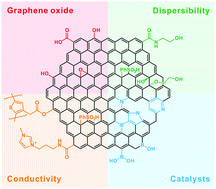Versatile graphene oxide nanosheets via covalent functionalization and their applications
Abstract
Even though many graphene derivatives that are atomically thin two-dimensional structures, such as graphene oxide (GO), have triggered enormous interest in the scientific and industrial communities owing to their easy synthesis and mass production, there is inevitable degradation of their properties compared to pristine graphene. This is because the sp2-carbon lattice of chemically oxidized GO is transformed into sp3-defect sites with various oxygen-containing functional groups. However, from a synthetic chemistry perspective, GO can become a robust and versatile carbon scaffold with utilizable surface functional groups via a variety of synthetic methods. In this regard, covalent functionalization with a diverse set of molecules on the surface of GO can not only recover diminished electrical and physical properties but also improve its overall performance in applications. In this review, we focus on the covalent functionalization of GO and present various strategies to control its dispersibility, conductivity, and catalytic activity toward potential applications. We anticipate that graphene chemistry will offer opportunities for designing multifunctional nanocomposites for future development in the materials science and device engineering areas.

- This article is part of the themed collections: Functional materials for sustainable future - Vision from Korean scientists and 2021 Materials Chemistry Frontiers Review-type Articles


 Please wait while we load your content...
Please wait while we load your content...